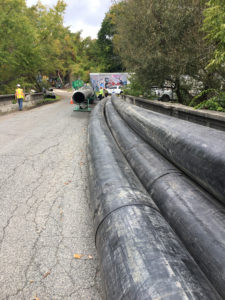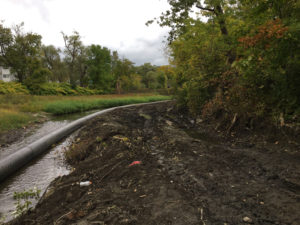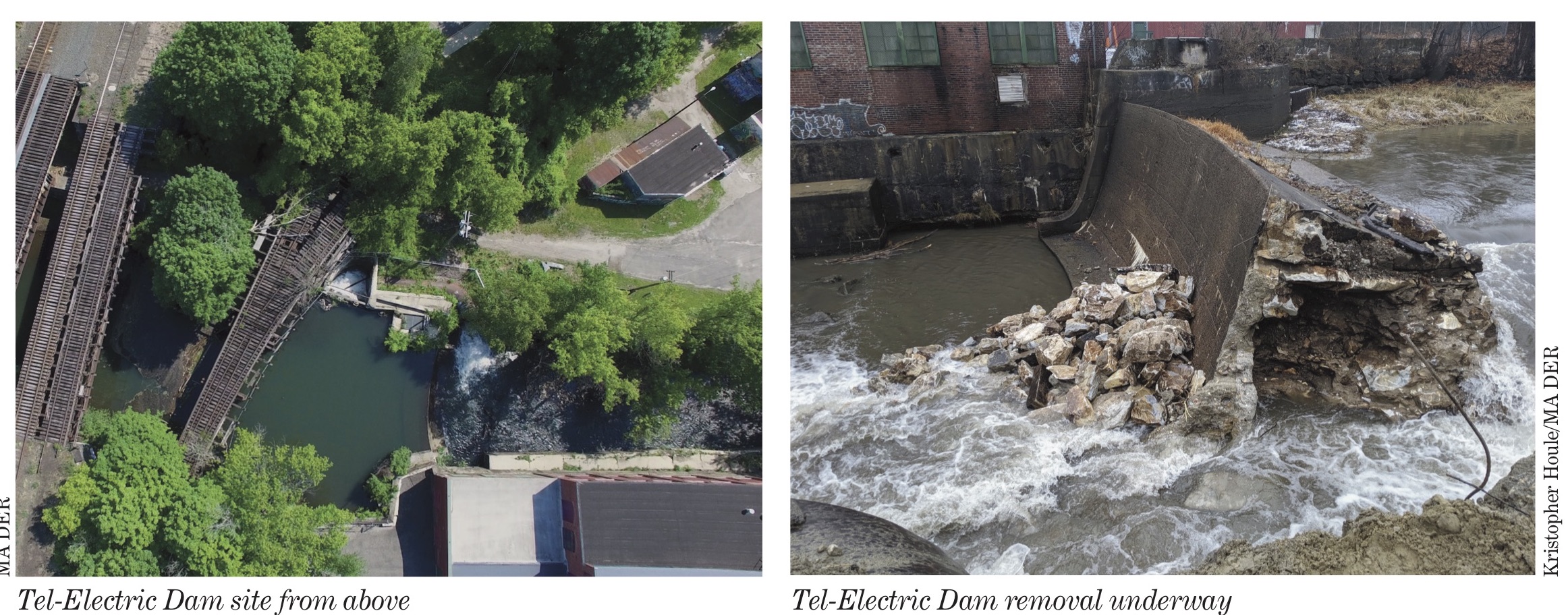→ scroll down for up to date project timeline ←

Pittsfield’s Tel-Electric Dam was built in the early 1900s by the Tel-electric Piano Player Company. The dam spans the west branch of the Housatonic River behind the Eagle Clock Tower building upstream of the Mill Street bridge. The Massachusetts Division of Ecological Restoration (DER) is working on several Berkshire County river projects to restore stream continuity and improve in-stream habitat, including the removal of the Tel-Electric Dam.

2019
December 11, 2019 – Pittsfield’s Tel-Electric Dam Down by Spring | The Tel-Electric Dam, on the West Branch of the Housatonic River, will soon be just a memory. The City of Pittsfield is leading a $3.8-million removal and restoration project, years in the making, with support from national, state, and local conservation partners. Read the full press release here.
Tel-Electric Dam Removal: Reshaping Pittsfield’s Relationship with the Housatonic | The Tel-Electric Dam — named for the company that produced mechanical piano players in the adjacent mill building — has been part of the Pittsfield community for more than a century. Manufacturing supported by the dam provided jobs and supported generations of families. Read the full US Fish & Wildlife info sheet here.
September 24, 2019 – You might have noticed these big, white bags next to the West Street bridge over the west branch of the Housatonic River. These will be used next week to funnel the river water into three 24” pipes from near the bridge, all the way down past the Tel Electric (aka Mill Street) dam!
 Right now crews are assembling these very long pipes.
Right now crews are assembling these very long pipes.

Soon they will move them into place. Then they will create coffer dams to funnel the water into the pipes. After that, they will de-water and remove tons of sediment accumulated upstream of the dam.
All of this is in preparation to remove the Tel Electric dam.
2018
October: Mass Wildlife and DER released a report stating new revisions to the dam removal project such as excluding sediment management from their goals. Instead they switched their focus to sediment removal and stabilization. Also, the removal site will be converted into a public greenway as a gravel path.
The Commonwealth of Massachusetts awarded $400,000 toward the removal project, putting funding over $2 million.
April: A memo from DER stated their preliminary engineering design has been completed, and were going to start examining the areas upstream of the dam for previously noted ecological issues by Massachusetts Environmental Policy Act (MEPA). Next steps included revisiting engineering methods that would ensure the utmost productivity moving forward, which involved sediment management, removal, and costs.

2016
June: BEAT arranged a public meeting at Conte Community School with participants from Mill Street Dam Removal and West Branch Housatonic River Restoration Project. Alex Hackman, Project Manager for the Mill Street Dam Removal and Restoration Ecologist for the Massachusetts Division of Ecological Restoration, explained the process in further detail. Jim McGrath, Pittsfield’s manager of Park, Open Space, and Natural Resources was also available to answer potential questions from attendants.
May: The Massachusetts Division of Ecological Restoration (DER) and the City of Pittsfield have filed an Expanded Environmental Notification Form (EENF pdf) and requested a waiver of the mandatory Environmental Impact Report because they felt they had provided enough information that no new environmental information would be added during that process.
A site visit was scheduled for May 27 at 9:30 am starting at the City of Pittsfield Maintenance Dept. Building, 18 Hawthorne Ave. Alex Hackman from DER was available to answer further questions after the site visit.
Comments were due July 8, 2016. This was an extended comment period to allow thorough review of the EENF by all interested parties.
2014
BEAT Sponsored a Pittsfield Green Drinks event to discuss dam removal with Alex Hackman. Hackman subsequently requested a bid for the City of Pittsfield on behalf of Mill Street Dam Removal.
2013
The Pittsfield Fire Department recovered a man’s body, believed drowned, from the Tel-Electric dam on June 26. The man was swimming upstream where the river empties into the dam spillway; where the man was pinned.
Talks arose once again about the dam’s fate. Seth Nash, co-owner of Pittsfield company Blue Q, and whose family owns the Tel-Electric dam, wanted the dam to be taken down since it is no longer used to power the nearby mill. John Daniels, Commissioner of Public Works, opposed this action because the dam could be utilized in an emergency to provide electricity.

2007
The entire Mill Street (Tel-Electric) Dam Removal Feasibility Study, Final Report of June 2006 is online (pdf). Pittsfield’s Director of Community Services James McGrath told the Pittsfield City Council that removing or lowering the Mill Street dam was one of the measures that the city was considering to improve the environment around Wahconah Park.
The dam is located roughly two miles from 3,100-seat Wahconah Park, which was listed on the National Register of Historic Places in the summer of 2005. Wahconah Park is within the flood plain of the Housatonic River’s western branch.
McGrath said the cost could be as much as $2 million dollars to remove or lower the dam. However, Tim Purinton, a river restoration planner with DER, said the cost estimates for the dam are “somewhat broad” because the amount of sediment located behind the structure hasn’t been determined yet.
The more sediment located behind a dam, the more expensive it is to remove the structure, he said. As an example, Purinton said removing Ballou Dam in Becket, which contained little sediment, cost only about $250,000.
BEAT supports the removal of this dam to restore river continuity. We would point out that the sediment removal behind Pittsfield’s dam could be especially expensive and time consuming because it likely contains PCBs, the amount and extent of which will have to be determined. While BEAT believes that the General Electric Company should bear the cost of testing and removal, the time factor will be annoying.
The removal of the Mill Street Dam has been listed as a Riverways’ Program priority project since 2005, when the agency accepted an application from the city of Pittsfield to have the dam removal placed on that list. The project is currently listed as being in the “feasibility” phase, and has been funded through the initial feasibility assessment.
The project will include an assessment to determine the feasibility and environmental benefits of removing the dam. The removal of the dam is expected to improve stream continuity all the way to the river’s main stem.
It is also being considered in tandem with improved public access — McGrath said the city is considering the establishment of a “greenway” between Wahconah and Clapp parks — and flood control to protect Pittsfield’s historic ballpark.
BEAT suggests that this flood control should include removal of the old landfill at the King Street Dump and its restoration to a functional wetland.
The preliminary feasibility study, alternatives analysis and a scour analysis had been completed, Purinton said, but a more detailed report, has yet to be done. The second scope of work will contain a public input phase, that will be accomplished by the scheduling of public hearings, he added. The Berkshire Regional Planning Commission is listed as the Riverways Program’s “project partner.”
Effects of removing the dam on the surrounding infrastructure also need to be determined, Purinton said. Unlike rural dams, urban structures are located near other properties, including buildings, and in the Mill Street dam’s case, railroad lines.
Purinton said that most dam removal projects can take years to complete. But he said they only take a “couple of years” once the funding pieces and permits are in place.



